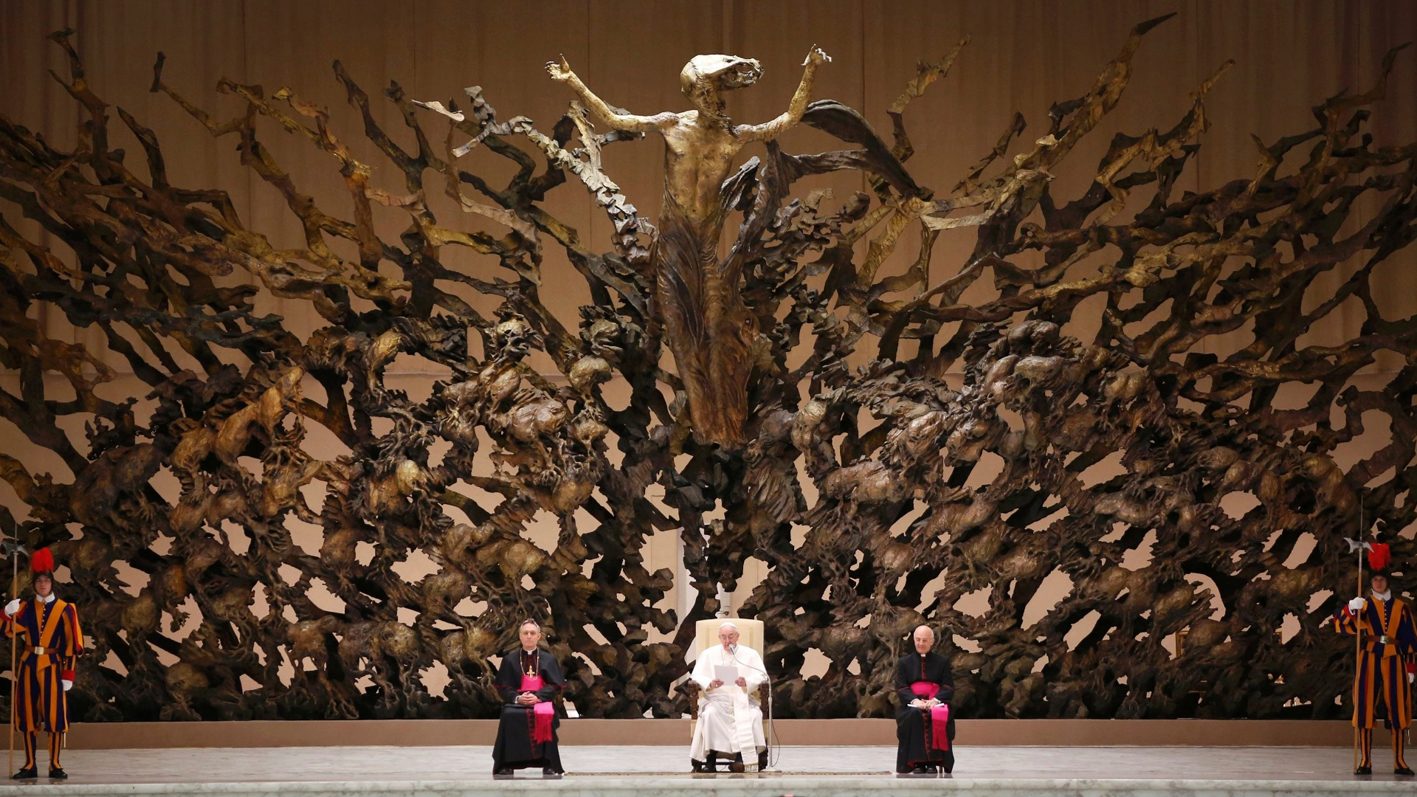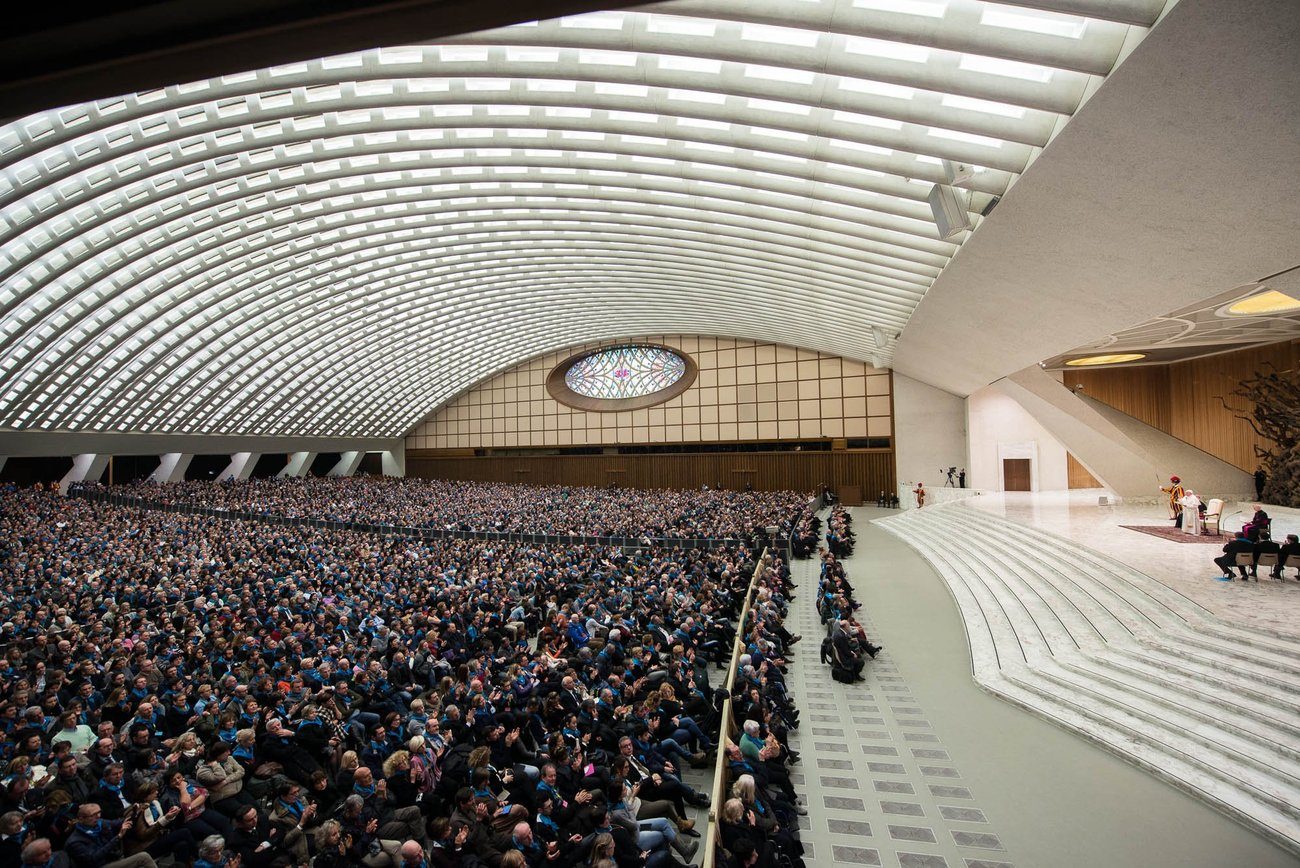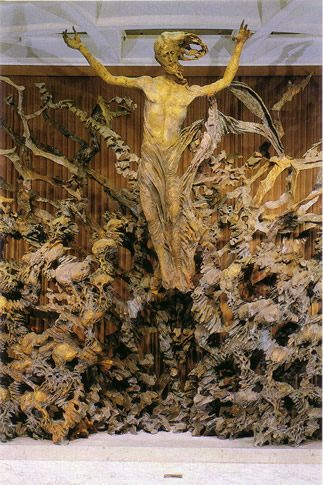{:en}Name any discipline in the field of art and you will easily discover the Marche contamination. The Marche region has given birth to women and men who have been able to leave their mark in the history of the arts, from ancient times to more modern times. One of these was Pericle Fazzini, an artist, sculptor and painter of great international prestige. One of his most famous works is preserved in the renowned Sala Nervi of the Vatican, it is one of the most visited sculptures in the world: The Resurrection.
 The work
The work
The Resurrection is a bronze sculpture commissioned by the then Pope Paul VI to Fazzini in 1965 and then finished by the sculptor in 1975, after five years of work completed in the Church of San Lorenzo in Piscibus in Rome. Fazzini's work was inaugurated in September 1977, in the presence of Paul VI himself. The location chosen for the placement of the work was none other than the Aula Nervi, the scenographic Audience Hall of the Vatican, intended for the conversation between the Pontiff and the people: an indelible sign of the Marche roots in an exclusive context. Measuring 20 meters wide, the statue is able to embrace the entire room, astonishing everyone present with its austerity and knottyness. In fact, the Resurrection, among the many Christian themes addressed over the centuries by painters, sculptors and all artists, is the least widespread. In this piece of extraordinary plasticity and form, Christ is radiant, even if the pain of the sacrifice can still be perceived from his gaze. Christ is supported by shapes that recall elements of the natural world, a chaos of roots and branches, an explosion, a Big Bang, life itself. The baroque influences favored by Fazzini are perceivable, although the world of matter and plasticity dominates the work.
 The author
The author
Defined by the illustrious Giuseppe Ungaretti as "poet of the wind", the artist who was Pericle Fazzini has, with his work and his thoughts, irremediably scratched the 900th century. He was born in Grottammare, in the Marche region, in 1913 and his training began in the family carpentry shop, before continuing in the capital where he moved to study. What was inexplicably striking about his work was the ability to take a step ahead of tradition, while always respecting it. However, it was the energy that his works transmitted that convinced patrons, connoisseurs and subsequently the Vatican that he was an extraordinary genius and that, for this reason, it was necessary to create a space in history. During his life he won numerous illustrious competitions and participated in major art events such as the Venice Biennale with his sculptures. He went as far as to exhibit in Japan, fully entering the international ranks and then culminating with his greatest work: The Resurrection. After his death in 1987, his art continues to live and, like the Risen Christ of his sculpture, to transmit the regenerative power that constantly renews his being and manifestations, just as he claimed Ungaretti.
«Christ rises from this crater opened by the nuclear bomb: an atrocious explosion, a vortex of violence and energy» (Pericle Fazzini){:}{:en}
Whatever art branch you mention, you will easily discover influences by Marche artists. The Marche region gave birth to women and men who were able to have an impact on the history of arts, starting from the ancient times to the modern days. One of those was Pericle Fazzini: an internationally renowned artist, sculptor and painter. One of his most famous works by him exhibits at the well-known Sala Nervi in the Vatican City, it is one of the most visited sculptures in the world: The Resurrection.
The work
The Resurrection is a bronze sculpture commissioned by Pope Paul VI to Fazzini in 1965, completed by the sculptor in 1975 after five years of work at the Church of San Lorenzo in Piscibus in Rome. Fazzini's work was inaugurated in September 1977 in the presence of Paul VI. The chosen seat for the work was the prestigious Aula Nervi, the spectacular Vatican's Hall of the Pontifical Audiences used for meetings between the Pope and the faithful: a permanent sign of Marche traditions in an exclusive context. With its width of 20 meters, the sculpture embraces the whole room, and amazes everyone with its severity and entanglement. The Resurrection is actually the least common subject among the several Christian subjects chosen across the centuries by painters, sculptors and artists. In this unique piece of extraordinary plasticity and shape, Jesus is radiant, even though you can see on His face the pain for Sacrifice. Jesus rises among figures that remind natural elements, a chaos of roots and branches, an explosion a Big Bang, that is Life in itself. Baroque influences are privileged for Fazzini and you can see them, although matter and plasticity is the main character of the work.
The artist
Described by the eminent Giuseppe Ungaretti “poet of the wind”, Pericle Fazzini was an artist who irretrievably scraped the Twentieth century with his work and his thoughts. He was born in Grottammare in the Marche region in 1913 and as a boy, he started working at the family carpentry workshop, then moved to Rome to study. What is amazing about his work is the ability to move a step forward, even though he was actually able to respect tradition. Patrons, experts and later the Vatican were convinced by the energy that his works di lui could impart, his genius di lui was one of a kind, so that it was necessary to create a space in history. In his life, he won several prestigious contests and exhibited his sculptures at very important art events such as Venice Biennale. He also exhibited in Japan and entered international circuits until he created the greatest of his works by him: The Resurrection. After his death di lui in 1987, his art di lui lives again and just like Jesus rises in his sculpture di lui, his works di lui are able to spread the revitalizing power that constantly renovates the human being and his expressions di lui, as Ungaretti would say.
«Jesus rises from a nuclear crater: a terrible explosion, a swirl of violence and energy» (Pericle Fazzini){:}


1 comment
[…] the Palazzo della Cancelleria, where the prelate had informed him that he should represent The Resurrection. After that, it was parked in the waiting room of a printing house like a […]